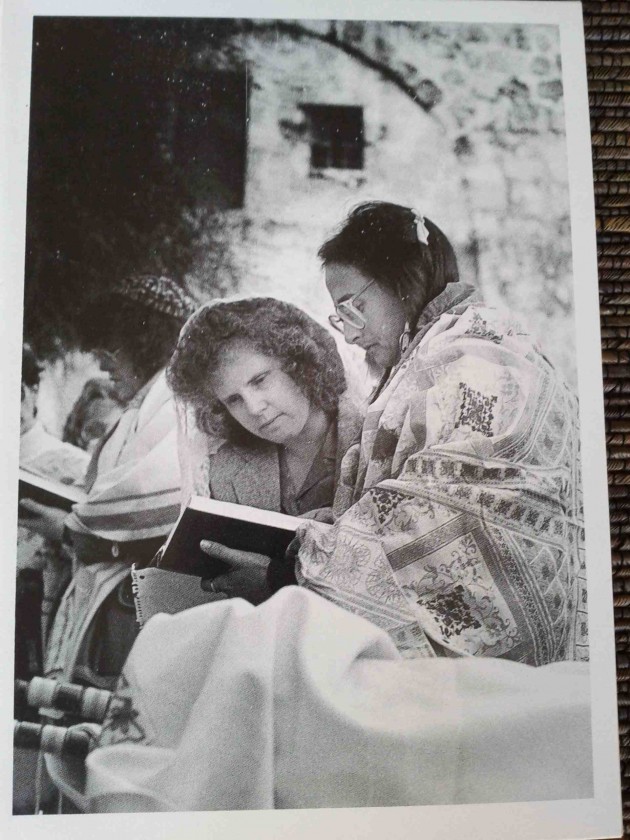
by Amy Stone
The Wall and I

Historic c Barbara Gingold, Jerusalem.
The Wailing Wall is dead – hopefully.
Not just because the term “Wailing Wall” has long been replaced by “Western Wall” or “Kotel” for the remains of the temple mount in Jerusalem but because of the victory – hopefully not short-lived – of Israeli state justice over Black Hats with political pull.
Separate and hopefully finally equal. In the women’s section of the wall, women can now put on all the ritual accoutrements of prayer traditionally worn by men and can conduct services, read from the Torah without getting hauled off by police for offending some Orthodox males in the men’s section of the wall.
Thank God. Or, more precisely, thank the sanity of the Israeli court system, not to be confused in any way with the beit din, the religious court where women are forbidden to give testimony, let alone judge.
The Wall and I Part One
My own relationship to the Wall goes back to the ‘60s. Heading home to New York after three years in Thailand (Peace Corps teacher then Bangkok Post reporter), I stopped in Israel. I landed in Lod (now Ben-Gurion Airport) on Shabbat – like landing in the bottom of an elevator shaft. Almost no way out.
I finally made my way to Jerusalem and to the Western Wall. Ignorant Reform Jew, I was shocked to find women separated from men. Temple Israel Religious School had not prepared me for the Jewish State. (Think 1950s assimilated suburban Judaism. My friend’s father, attending a bar mitzvah at Temple Israel, was told to remove his yarmulka.)
My touchdown in Israel was in 1968, one year after the Six-Day War. Israelis were heady with joy – the Western Wall was accessible at last, along with a glorious new day for Israel and the rest of the Jewish world. Israelis were shocked that I wasn’t staying.
Four years later, 1972 – the Women’s Movement had blown open my mind. Working on Wall Street Week at Maryland Public Television, I asked to have my writer credit removed from the show. I didn’t want anyone to think I had anything to do with host Louis Rukeyser’s not-amusing sexist banter. I did birth control and abortion counseling from behind my office doors. I inserted Dalkon Shield IUDs at the People’s Free Medical Clinic. I went to Israel to check out my Jewish roots.
The Wall and I Part Two
I arrived in Israel just after the Munich Olympic massacre of Israeli team members in 1972 and the bombing of the Super Sol in Jerusalem. This distracted me for a while from realizing that once again Temple Israel had not prepared me for Israel. In post-confirmation class in the rabbi’s study, we had learned that Orthodox Judaism was in the museum, gathering dust.
Not.
Orthodox Judaism was alive and well and running much too much of the Jewish State. And this was in the relatively benign days when the first religious settlement was just making its fledgling start on the West Bank outside Hebron. (Who knew from Judea or Sumaria.)
Even though I stayed away from the Wall, that seemed the place to go on Yom Kippur. In the women’s section, Yom Kippur 1973. I was probably one of the last in Israel to know the Yom Kippur War had broken out.
I went back to New York early the next year and became part of Lilith – thrilled to discover all these super knowledgeable women had been worrying about the second rate status of women in Judaism long before my awakening.
The Wall and I Part Three
My one ongoing – up to the present – connection to the Wall has been my diminishing supply of Women of the Wall cards with a black and white photograph by Barbara Gingold dated 1989. In this first gathering, women sweetly read from prayer books in front of the Wall. At least one is wearing a traditional tallis and a kippah. A modestly wrapped Torah occupies the foreground. I’ve probably had these cards for more than 20 years. On the back: “Proceeds from the sale of this card help support the Women of the Wall in their efforts to advance the status of women in Judaism.”
Thanks for hanging in there, Women of the Wall.
Learn more at the Facebook page for “Wake Up for Religious Tolerance! Rosh Hodesh Sivan.”